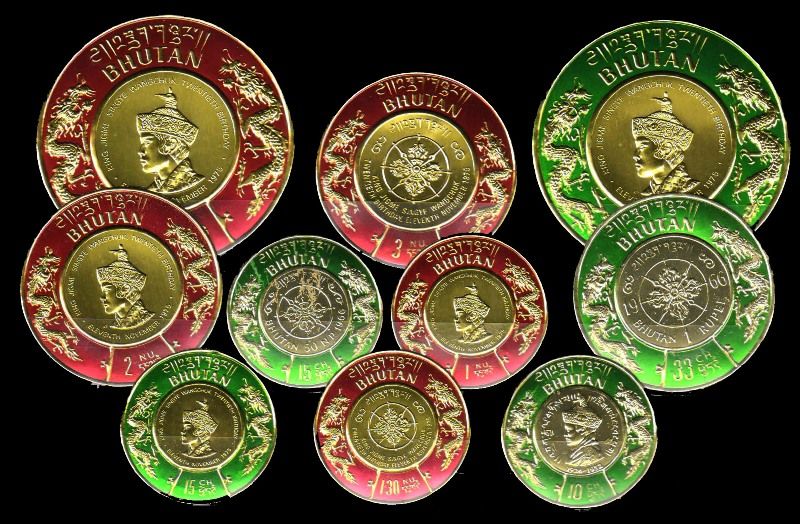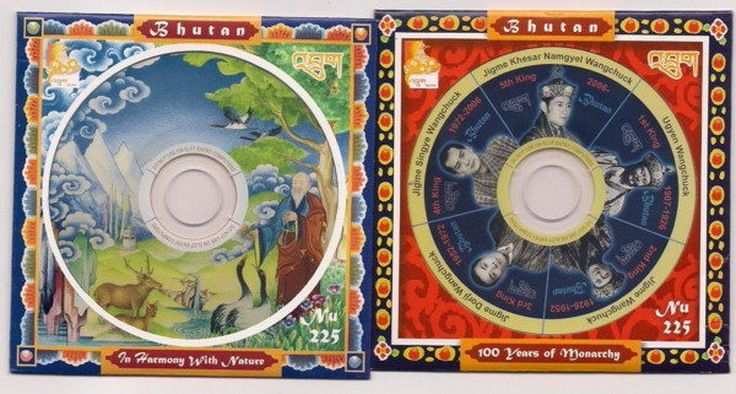Bhutan, a small landlocked country sandwiched between India and China, barely attracts attention in the international arena. Its postage stamps, however, are the most sought after by philatelists. Among those most prized are stamps that are printed on silk and steel foil instead of paper, and the strangest yet are printed on miniature vinyl records that could be played on a record player.

Vinyl record stamps of Bhutan.
Bhutan did not have an organized postal system until the early 1960s. Domestic mail was carried by mail runners or the casual traveler, and foreign correspondence was routed through the Indian postal department. With the start of development programs in Bhutan and the end of its self-imposed isolation in the late 1950s and early 1960s, there was a sizeable increase in the number of mail items, forcing the government to establish a postal service. In 1962, the country issued its first postage stamp.
One person who was instrumental in helping Bhutan launch postage stamps was the wealthy American businessman Burt Kerr Todd. While studying at Oxford University in the late 1940s, Todd met Ashi Kesang Choden-Dorfi, the future queen of Bhutan, who was the first person from her country to study in the West. Two years after graduation, in 1951, Todd received an invitation from the Bhutanese royal family to visit the tiny mountainous country.
Todd had no idea how difficult it was to reach Bhutan until he reached India. There he learned that Bhutan had no air service and no roads into the country, and the only access was on foot or on the back of mules over wild mountain tracks. But Todd and is friends persevered and finally made it into the capital where they received a royal welcome.

Circular coin stamps made of foil.
Todd fell in love with Bhutan, its friendly, hospitable people and its traditional centuries-old customs. When he went back to America to get married, he brought his bride back to Bhutan for their honeymoon.
Todd became close friends with the royal family, and because of his family’s influence on the US industrial scene, Todd was asked to become an honorary financial advisor to the Bhutan government. In 1959, when the Bhutanese government decided to apply to the World Bank for a $10 million loan, Todd became a key advisor in shaping the application. But the bank refused the loan; the bank wanted to keep good terms with India with whom Bhutan was in a border dispute. An official suggested that Bhutan could try and raise money by issuing postage stamps, as some of the small states such as San Marino and Monaco did.
Todd made some investigation and realized that issuing stamp was indeed a great way to raise money. The Bhutanese government was skeptical, but agreed to the project, and Todd set up the Bhutan Stamp Agency, a private company established in the Bahamas, which would produce the stamps and handle their sale on the international market.
In 1962, Bhutan released the first stamps, a set of seven attractive designs featuring a postal runner, the Crest of Bhutan, an Archer, a Wild Yak, a Map of the Country, and the Maharaja fortress and monastery. Although the stamps were pretty, they failed to arouse interest among philatelist, largely because Bhutan was an unheard of country. More importantly, stamp collectors rely on a closed system of philatelic trade channels and on specialized journals, but Todd had no knowledge of these. Over time Todd sought and received the advice of insiders, and gradually he began to realize that in order sell stamps he needed to make them highly attractive.
Todd’s first innovation was a circular stamp to mark the 40th anniversary of the accession of King Jigme Wangchuk to the Bhutanese throne, using a heraldic design embossed in gold on rainbow-colored paper. This was followed by a set of triangle-shaped stamps showing the “Abominable Snowman”. Serious philatelists dismissed them as gimmicks, but general collectors lapped them up.

In 1967, Todd came up with the world’s first three-dimensional stamps on the theme of space exploration. The design showed spacemen and spacecraft printed on a laminated prismatic-ribbed plastic surface which gave them a convincing three dimensional effect. The 3D stamps set the philatelic world on fire, and hundreds of thousands of sets were sold. After the success of the 3D stamps, Burt released a slew of remarkable designs. The bas-relief stamps depicted famous sculptures and personalities in molded plastic. Then, there were the Religious Banner series in 1969 printed on silk.

Three dimensional stamps.

Bas-relief stamps.
The same year Bhutan issued 12 stamps printed on hair-thin 0.001 inch steel foil to commemorate and emphasize the importance of steel industry. The most unusual of them all were the so-called “talking stamps”. Issued in 1973 in multiple colors, the talking stamps were miniature one-sided vinyl records with adhesive backs so that they could be affixed to letters, but also played on a standard turntable. The stamps featured audio recordings of folk songs, the national anthem, the history of Bhutan in Bhutanese and the history of Bhutan as narrated in English by Burt Kerr Todd himself. The talking stamps are the most sought after today, with a single piece selling for hundreds of euros.
In 1974, two years after the death of the third King Jigme Dorji Wangchuck, the contract with the Bhutan Stamp Agency was cancelled. The responsibility of designing, printing and marketing stamps was awarded to the Inter-Governmental Philatelic Corporation (IGPC), a New York-based company representing many small and developing countries.
Since 1996, the Bhutan Post has been designing its own stamps and they continue to innovate. In 2008 Bhutan Post released CD-ROM postage stamps, another world first, as part of Bhutan’s commemoration of the 100th anniversary of its monarchy. The small-format disc contains video documentaries of events from Bhutan’s history: the anniversary of the monarchy, the coronation of the Fifth King, and the signing of the new Constitution.
Stamps continue to generate a small income for Bhutan, even though the global philately market has been declining due to the use of alternative communication methods, such as email and text messages, but also due to the lack of enthusiasm of young collectors. In 2008, sale of stamps generated a profit of 8 million ngultrum (US$74,000). That figure in 2015 was already 13 million (US$196,000).

CD-ROM stamps.
References:
# Little Ambassadors of the Country, Works That Work
# Bhutan Postal Museum
# Burt Todd and the Stamps of Bhutan, Philatelic Database












Comments
Post a Comment